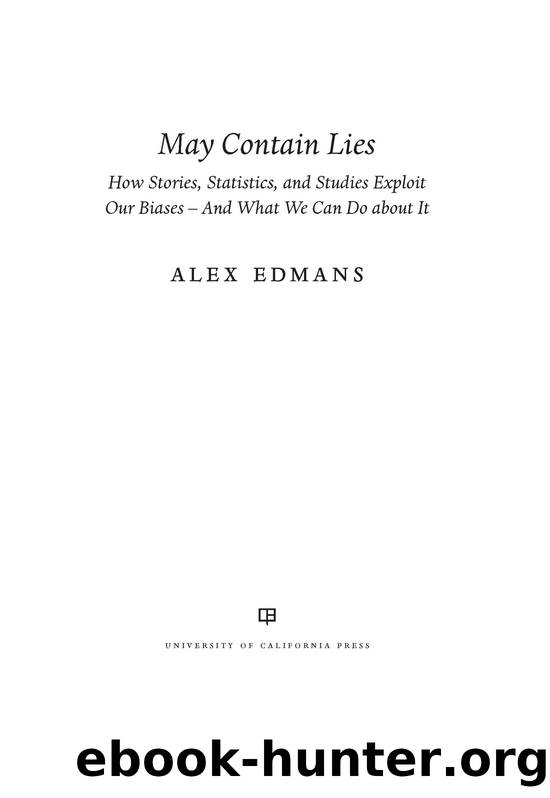May Contain Lies by Alex Edmans;

Author:Alex Edmans;
Language: eng
Format: epub
ISBN: 9780520405851
Publisher: University of California Press
A shock to the system
Given the success of RCTs across a variety of fields, you might hope to use them for the debate on whether parental choice improves school performance. Youâd randomly merge some school districts (the test group ), keep your nose out of others (the control group) and compare their outcomes.
But such an experiment would be both costly and risky. The expense of merging school districts is huge, and if competition does improve performance, thousands of kids in the merged districts will suffer worse education. This is the key limitation of RCTs: theyâre effective where you can use them, but sometimes the consequences of putting people in the wrong group are so severe that you canât take the risk. To test if smoking causes cancer, you canât recruit volunteers and force half of them to smoke; to verify Belle Gibsonâs advice, you canât sign up cancer patients and order 50% to forgo chemotherapy for clean eating.
In situations like this, you canât conduct an intervention study â you canât intervene and change the input yourself â so what you need is something that already does so in the real world. This is known as an instrument.** An instrument causes the input to change, but for random reasons that have nothing to do with the output. In simple terms, itâs a shock to the system. You can then observe what happens after the input was shocked and conduct an observational study that requires no intervention.
A famous paper by economist Caroline Hoxby used rivers as an instrument for school choice to solve our education conundrum.4 In the US, school districts were formed in the eighteenth century, when crossing a river was difficult because there were no cars and few bridges. As a result, districts rarely crossed rivers, so that children wouldnât need to do so to get to school. Metropolitan areas with several rivers thus had multiple districts; since districts havenât changed much over time, these areas still have many today.
Hoxby decomposed the input â school choice â into two parts: the exogenous part that can be attributed to the instrument (rivers) and the endogenous part that canât (and instead arises from common causes like parental engagement).â â Then, she linked only the exogenous part to the output: student performance. Common causes donât affect exogenous school choice â thereâs no arrow between them â so they canât be the reason for any correlation between exogenous school choice and performance.
Download
This site does not store any files on its server. We only index and link to content provided by other sites. Please contact the content providers to delete copyright contents if any and email us, we'll remove relevant links or contents immediately.
| CPA Test | GMAT Test |
| Statistics |
Cracking the GRE Premium Edition with 6 Practice Tests, 2015 (Graduate School Test Preparation) by Princeton Review(3607)
What It Really Takes to Get Into Ivy League and Other Highly Selective Colleges by Hughes Chuck(3228)
Fooled by Randomness: The Hidden Role of Chance in Life and in the Markets by Nassim Nicholas Taleb(2428)
The Marketing Plan Handbook: Develop Big-Picture Marketing Plans for Pennies on the Dollar by Robert W. Bly(2423)
The Tyranny of Metrics by Jerry Z. Muller(2414)
The Official Guide for GMAT Review 2015 with Online Question Bank and Exclusive Video by Graduate Management Admission Council (GMAC)(2345)
Ultralearning by Scott Young(2333)
50 Economics Classics by Tom Butler-Bowdon(2072)
The Visual MBA by Jason Barron(1638)
The Inevitable by Kevin Kelly(1562)
Data Science for Business by Foster Provost & Tom Fawcett(1519)
Out of the Crisis by Deming W. Edwards(1506)
GMAT Official Guide 2018 Verbal Review by GMAC (Graduate Management Admission Council)(1390)
Cracking the LSAT, 2012 Edition by Princeton Review(1352)
The Conflict Resolution Phrase Book by Barbara Mitchell & Cornelia Gamlem(1351)
Maths and Stats for Web Analytics and Conversion Optimization by Himanshu Sharma(1304)
The Personal MBA: Master the Art of Business by Josh Kaufman(1277)
College Essays that Made a Difference by Princeton Review(1271)
Cracking the SAT Premium Edition with 6 Practice Tests, 2017 by Princeton Review(1260)
